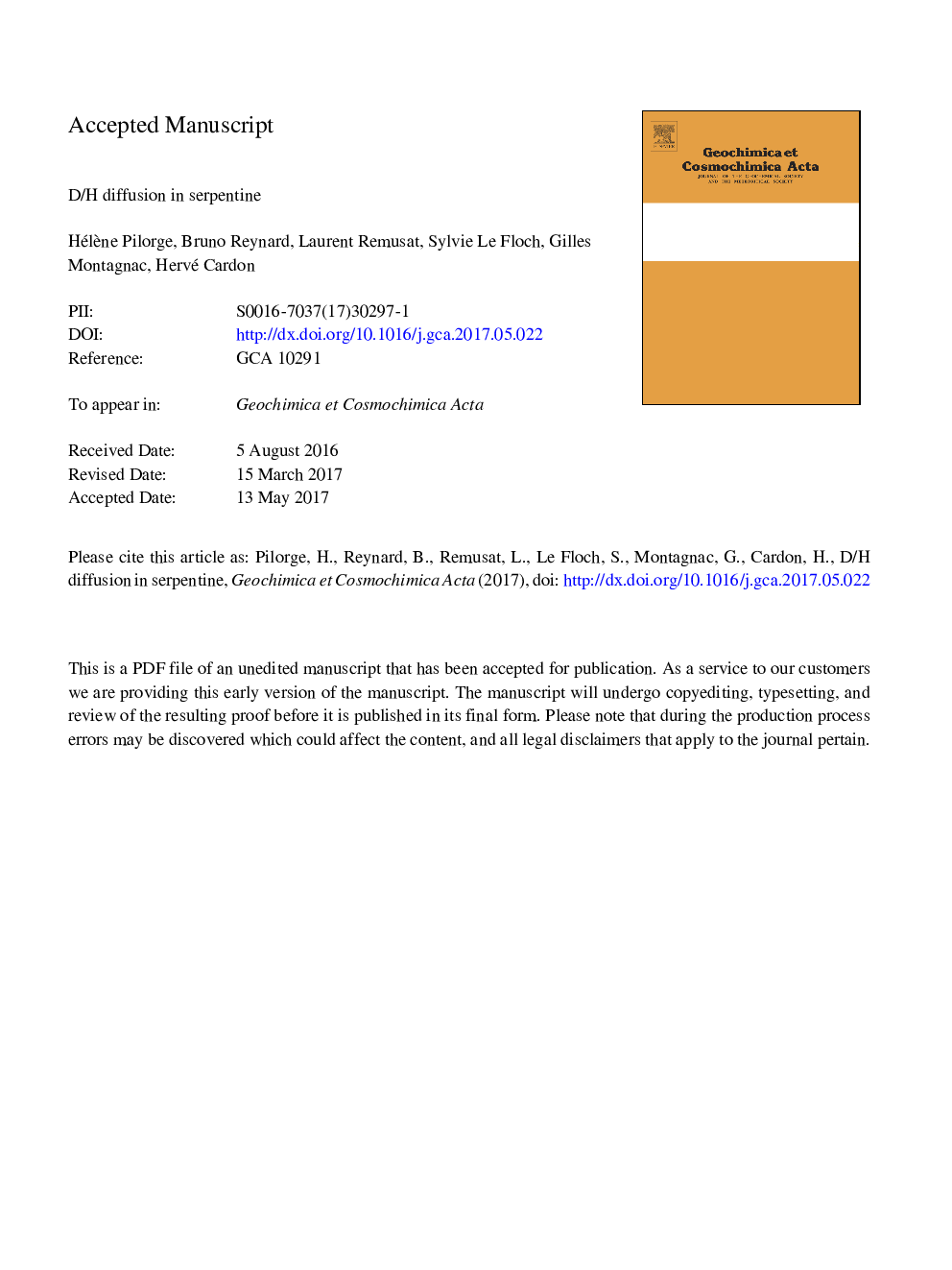| کد مقاله | کد نشریه | سال انتشار | مقاله انگلیسی | نسخه تمام متن |
|---|---|---|---|---|
| 5783402 | 1637946 | 2017 | 48 صفحه PDF | دانلود رایگان |
عنوان انگلیسی مقاله ISI
D/H diffusion in serpentine
دانلود مقاله + سفارش ترجمه
دانلود مقاله ISI انگلیسی
رایگان برای ایرانیان
کلمات کلیدی
موضوعات مرتبط
مهندسی و علوم پایه
علوم زمین و سیارات
ژئوشیمی و پترولوژی
پیش نمایش صفحه اول مقاله

چکیده انگلیسی
Interactions between aqueous fluids and ultrabasic rocks are essential processes in a broad range of contexts including hydrothermal alteration on the parent body of carbonaceous chondrites, at mid-oceanic ridge, and in subduction zones. Tracking these processes and understanding reaction kinetics require knowledge of the diffusion of water in rocks, and of isotope fractionation in major minerals forming under hydrous conditions, such as serpentines. We present a study of D/H inter-diffusion in antigorite, a common variety of serpentine. Experiments were performed in a belt apparatus at 315 °C, 450 °C and 540 °C and at 3.0 GPa on natural antigorite powders saturated with interstitial D2O. An experiment was performed in a diamond anvil cell at 350 °C and 2.5 GPa on an antigorite single-crystal loaded with pure D2O. D/(D + H) ratios were mapped using Raman spectroscopy for the experiments at 315 °C, 450 °C and 540 °C and by NanoSIMS for the experiment at 350 °C. As antigorite is a phyllosilicate, diffusion coefficients were obtained for crystallographic directions parallel and perpendicular to the silicate layers (perpendicular and parallel to the câ-axis, respectively). Arrhenius relations for D/H inter-diffusion coefficients were determined to be DD/H (m2/s) = 4.71 Ã 10â2 Ã exp(â207(â33/+58) (kJ/mol)/RT) and DD/H (m2/s) = 1.61 Ã 10â4 Ã exp(â192(â34/+93) (kJ/mol)/RT) perpendicular and parallel to the câ-axis, respectively, and DD/H (m2/s) = 7.09 Ã 10â3 Ã exp(â202(â33/+70) (kJ/mol)/RT) for the bulk diffusivity. Assuming D/H inter-diffusion coefficients for antigorite are the same for all serpentine species, closure temperature and diffusion durations are applied to hydrothermal alteration in the oceanic lithosphere, and in CI, CM and CR chondrites. Closure temperatures lie below 300 °C for terrestrial hydrothermal alteration and depend on serpentine variety because they have different typical grain sizes. Closure temperatures lie below 160 °C for carbonaceous chondrites, indicating that D/H isotopic exchange may have persisted down to very low temperatures in their parent bodies. Local D/H isotopic compositions may be associated with grain size heterogeneities in carbonaceous chondrites due to protracted alteration of fine-grained material with the lowest closure temperatures (ca 80 °C).
ناشر
Database: Elsevier - ScienceDirect (ساینس دایرکت)
Journal: Geochimica et Cosmochimica Acta - Volume 211, 15 August 2017, Pages 355-372
Journal: Geochimica et Cosmochimica Acta - Volume 211, 15 August 2017, Pages 355-372
نویسندگان
Hélène Pilorgé, Bruno Reynard, Laurent Remusat, Sylvie Le Floch, Gilles Montagnac, Hervé Cardon,